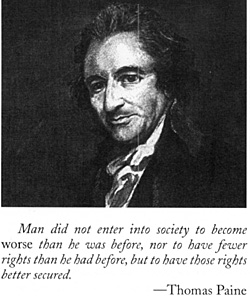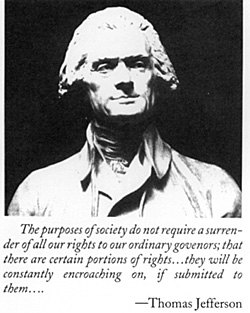 "We hold these truths to be self-evident,
that all men are created equal, that they are
endowed by their Creator with certain unalienable
Rights, that among these are Life,
Liberty, and the pursuit of Happiness. That
to secure these rights, Governments are instituted
among Men, deriving their just powers
from the consent of the governed. That whenever
any Form of Government becomes destruct of
these ends, it is the Right of the People to alter or
abolish it...."
"We hold these truths to be self-evident,
that all men are created equal, that they are
endowed by their Creator with certain unalienable
Rights, that among these are Life,
Liberty, and the pursuit of Happiness. That
to secure these rights, Governments are instituted
among Men, deriving their just powers
from the consent of the governed. That whenever
any Form of Government becomes destruct of
these ends, it is the Right of the People to alter or
abolish it...."
As the end of the 20th century approaches, the revered phrases of the Declaration of Independence have taken on fresh meaning. There are serious signs of conflict on the American scene. Efforts to further expand bureaucracy are now opposed by a rising tide of chaos. Law enforcement agencies are increasingly paramilitary. Computers and cybernetics offer vast new opportunities to evade and resist traditional lines of authority.
Could these elements combine to produce open civil conflict? The United States may well be added to the list of nations experiencing turmoil and revolution at the start of the next millennium.
Man did not enter into society to become worse than be was before, nor to have fewer rights than be bad before, but to have those rights better secured.
- --Thomas
Paine
The Organizational State
The 20th century witnessed a vast expansion in organizational power everywhere, ineluding the United States. The causes of this transformation were:
- An increase in the power of the centralized federal government at the expense of the states and localities.
- The establishment of a managerial economy, centrally controlled through directives, regulations, and taxation. In return for industry's surrender of market- based laissez-faire principles, government provides private business with grants, price supports, and bailouts.
- The growth of security forces. A large peacetime defense establishment has become the norm in America, to which must be added the development of diverse intelligence agencies and the increase in paramilitary style police forces.
This process accelerated in the years following 1984 (thank you, George Orwell!) when the Federal government and its allies in private industry, the media, and the universities focused their attention on suppressing elements deemed responsible for disrupting organized society." Hence the campaigns to prohibit illicit drugs, control firearms, attack promiscuous sexual conduct, and censor free expression (rock music, violent television images, offensive speech). The government has even begun moving against the freedom enjoyed in "cyberspace" by proposing that all computers be equipped with "Clipper Chips" that will permit officials to read any computer traffic once they get a court order - and probably even if they don't!
What is the objective?
George Orwell, in his classic work 1984, points out that in order for a modern ruling class to retain its power it must convince the citizens that life consists of work followed by controlled entertainment, particularly visual images on television. Work maximizes industrial productivity and taxes paid to support the state structure. Television serves as the modern-day opiate of the masses: a populace safely watching television can be subjected to government- or corporate-approved messages and will not be out on the streets committing crimes or participating in disruptive radical politics.
Much of the citizenry has accepted this arrangement. It provides security in the form of employment, state subsidized education, social security, and cheap entertainment. But can this system maintain its stability in the face of chaotic challenges?
Strange Attractors
 One of the key crises facing the United
States is potential economic collapse. The US
national debt has reached the incredible sum of
$4.5 trillion dollars and it is growing. The Kerrey
Commission declares that the Social Security
trust fund will go bankrupt sometime between
2013 and 2029. Much of America's financial and
industrial base is undergoing deconstruction as
corporate leaders choose to relocate industry
abroad, and wide-scale corruption consumes what
is left. The savings and loan crisis, for example,
destroyed millions of peoples' solvency and cost
the country an estimated $500 billion.
One of the key crises facing the United
States is potential economic collapse. The US
national debt has reached the incredible sum of
$4.5 trillion dollars and it is growing. The Kerrey
Commission declares that the Social Security
trust fund will go bankrupt sometime between
2013 and 2029. Much of America's financial and
industrial base is undergoing deconstruction as
corporate leaders choose to relocate industry
abroad, and wide-scale corruption consumes what
is left. The savings and loan crisis, for example,
destroyed millions of peoples' solvency and cost
the country an estimated $500 billion.
The result of all these factors is economic decline, and with it increasing popular frustration. People realize that they cannot expect to live lives as good as their parents, and there is no guarantee of a better future. Crime, radicalism, promiscuity, worker malaise, and general cynicism are the result. Youth is especially alienated, as it becomes evident that the social welfare state they are paying for through taxation will not be in place to serve them in the future.
The government's response to these "negative behaviors" has been increasing regulation of private activities. Yet this regulation only spawns resistance based on the American predilection for individual freedoms. Take gun control, for example. Legislation requiring firearms owners to register or surrender their weapons has been met with widespread civil disobedience.
Whatever the objective merits of gun control, the fact of the matter is that a large sector of the American people believes it has a right to bear arms, regardless of the social costs. Similar reactions have occurred when limits have been placed on free speech, privacy, and religious exercise.
There are also centrifugal forces encouraging local autonomy in the face of centralization. A number of state governments have passed resolutions demanding that the national government respect 10th Amendment strictures limiting federal powers. Several have even contested federal control of territories within their boundaries.
The greatest threat to centralized structures now comes from cybernetics. Computer communications networks ("nets") create self-sufficient infrastructures. Users ("cybernauts") can withdraw from required government programs. For example, it is possible to create a shadow economy in which wealth is measured entirely in terms of electronic- communications services rendered or received.
Cybernetics will also have a tremendous impact on social structure. The standard labor environment in the Western world since the industrial revolution has been the managed factory or office space. This has allowed concentration of personnel in hierarchical, centralized structures for reasons of efficiency and control. But with computers, the switch to a service economy supplied by automated assembly lines permits the decentralization of the workplace.
Economic structures suitable for the 19th century will not persist for very long into the 21st. With people free to set their own working hours and environment, they will also be free to explore personal fulfillment to a greater degree than ever before.
As history demonstrates, radical changes inevitably lead to political conflict. Obviously, those who benefit from today's centralized and hierarchical structures will resist trends that will put an end to their power. This trend will generate confrontation and conflict. As long as authority's only response to disorder is to bolster the old order, the result will be a rising tide of turbulence. This relationship represents the American government's dilemma.
The purposes of society do not require a surrender of all our rights to our ordinary govenors; that there are certain portions of rights ... they will be constantly encroaching on, if submitted to them.... --Thomas Jefferson
Iteration of Error
The government thus finds itself in a negative feedback loop. As chaos increases, the state attempts to implement more controls on society Yet these controls only exacerbate the situation without solving any of the problems. The end result is a vicious circle that hastens the day of reckoning.
For example, the reasons for the rise in urban crime have to do with a complex series of events. These include:
- Radical changes in the nature of the economy as industry converts to different technologies, thereby destroying the traditional social basis of communities.
- Flight of capital from the cities as industrialists seek to avoid oppressive taxes and regulations.
- Rise of a large, disaffected "Generation X" youth sector.
- Clashes between diverse ethnic groups.
- Ineffective social welfare programs and corrupt police departments.
Governments have essentially ignored the underlying factors and focused their energies upon a "war" on crime. Constitutional safeguards on searches and seizures have been dropped, arrests increased, and the prison population multiplied many times in an attempt to restore order.
More recently, the government has established "boot camps" for young offenders. In these detention camps, inmates are subjected to military-style regimentation and discipline. The idea is that work makes one free of criminal impulses. The logic behind the boot camps is somewhat deficient: giving military training to potential insurgents may prove to be counterproductive in the long term.
Despite this "war" on crime, individual citizens feel less secure than ever. The reason that these hardline measures have failed is that they do not address the real causes of impending social collapse discussed earlier. Problems fester as national energies and resources are plowed into dead-end programs.
Increasing the numbers of arrests, for example, does nothing to balance the federal budget. One of the reasons the underlying factors are not addressed is that it would mean attacking the very power structure in the United States itself - the political, corporate, and law enforcement leaders who were responsible for inept and corrupt policies in the first place.
As society becomes increasingly criminalized by widening government prohibitions, lawless turbulence increases proportionally. The result is a government that flounders from one crisis to another without making any progress in any of its internal "wars." What the policies of the past decade have done is se the stage for real catastrophe.
Catastrophic Insurgency
 At what point will America reach the
point of no return? The televised beating of
Rodney King was sufficient to trigger long-
standing resentments among Los Angeles'
underclass, leading to several days of rioting in
1992. Incidents like the Rodney King affair take
on lives of their own because to many they
represent government assaults on the individual.
The potential now exists for turning such
incidents into genuine ongoing insurgencies.
At what point will America reach the
point of no return? The televised beating of
Rodney King was sufficient to trigger long-
standing resentments among Los Angeles'
underclass, leading to several days of rioting in
1992. Incidents like the Rodney King affair take
on lives of their own because to many they
represent government assaults on the individual.
The potential now exists for turning such
incidents into genuine ongoing insurgencies.
When viewed in the light of classic insurgency theory, the US government has made many errors that could be exploited by rebel cadres. The government has no realistic objectives; firearm and drug prohibitions have invariably failed. It does not mobilize popular support, relying instead on ponderous bureaucracies and a few elite law enforcement agencies. It does not act within the law, as massive government violations of the Bill of Rights attest. Above all, it has failed to deal with the real political and social problems.
Ultimately, a government must have popular support, or it will be denied recruits, intelligence information, and compliance with its laws. This lesson had to be learned the hard way by many Third World countries that faced insurgencies during the Cold War era. The majority of recruits for an insurgency come from people who have been victimized by indiscriminate government terrorism or who have had friends or relatives victimized.
As authority alienates more people, voluntary support for the state disintegrates. The millions of Americans who have had their rights violated through bureaucratic excesses are ripe targets for insurgent recruiting.
Guerrilla warfare will not be conducted as it has been since WWII. Classical insurgency of the Leninist-Maoist variety depended upon guerrillas out-organizing the government by creating their own superior political and military infrastructures. These infrastructures would then conduct coordinated propaganda and guerrilla operations that were byond the training of government forces to cope with.
Yet these hierarchical insurgencies have been largely defeated in recent years. In the 1970s, European security forces destroyed the urban Marxists that openly challenged governments. In the 1980s, most ofthe Marxist insurgencies in Latin America were countered by effective counter-insurgency strategies. Government security forces, learning from past mistakes, thus proved able to outorganize and out-fight the insurgents. The problem for authority today is that rigidly organized insurgencies are not the wave of the future. Insurgent guerrilla warfare will no longer depend upon armed raids and ambushes. [See The Battle for Cyberspace on page 22 for how modern technology could be employed to wage a bloodless war.]
It is not men's immorality that is responsible for the collapse now threatening to destroy the civilized world, but the kind of moralities men have been asked to practice. The responsibility belongs to the philosophers of altruism. They have no cause to be shocked by the spectacle of their own success, and no right to damn human nature: men have obeyed them and brought their moral ideals into.full reality.
- --Ayn Rand
Chaotic Warfare
The recent United Nations experience in Somalia demonstrates that overwhelming military power does not translate into victory against a loosely organized resistance movement. The main advantage of the Somali guerrillas was the very chaos of the situation. The important thing to grasp is that, unlike orthodox insurgencies, there was no "Insurgent infrastructure" for UN forces to attack and neutralize. It was simply impossible for UN forces to strike against a nonexistent Somali center of gravity. The mere fact that the Somalis resisted was enough.
In this, they were motivated by a traditional warrior ethos, with a powerful assist from some UN tactical blunders. Gradual attrition of morale through minor actions and endless casualties eventually forced UN troops back into fortified enclaves and led to their withdrawal. The Soviets experienced a similar situation in their decade-long war in Afghanistan.
There are also some serious questions about the efficacy of American internal security about the efficacy of American internal security forces. A good example is the ATF/FBI raid on the Branch Davidian group in early 1993. Although the use of paramilitary police tactical forces has been widespread in the United States, the Waco, Texas raid revealed flaws in the concept. As soon as the federal agents met determined resistance at the Davidian compound, the entire attack fell apart.
The raid degenerated into a siege, which would have been farcical were it not for the fact that the final assault resulted in the deaths of around 100 men, women, and children. What the Waco action indicates is that, despite military uniforms and assault rifles, most law enforcement organizations are simply not capable of conducting efficient combat operations. The police lack the discipline, leadership, and organization to function as military units.
There is also doubt about whether law enforcement agencies and the military will obey orders to fire on Americans. Many members of the police and armed forces obviously do not support government policies [see Coup of2012 on page 81. There have been occasional incidents where local law enforcement officials have refused to cooperate with federal agencies. Obviously, if dissenting police defected to insurgents it would be a critical, possibly decisive step toward outright revolution.
The recent experience of the successful anti-Soviet revolutions in Eastern Europe indicates that the main front for contemporary civil conflict is in the cities. They contain the majority of the populace, the media, the government centers, and the rising tide of technological change. Mass demonstrations and confrontations in urban areas would probably be the main battlefield. Again, as the experience of Eastern Europe shows, such confrontations can bring down governments with a minimum of bloodshed. There are also the traditional means of civil disobedience, which had a powerful though as yet unappreciated effect on the collapse of European Communism. What would happen if millions of Americans simply refused to comply with various governmental directives controlling their lives.
The more the US Constitution is undermined by repressive activities, the less legitimate the government becomes, and the more its political power decays. Any revolutionary movement could then claim it was fighting for the true American values of individual liberties and rights.
It is the central moral principle of Western civilization that individuals make their own moral choices, clearly stated in the United States Declaration of independence; but the government has violated this principle with massive interference in individual liberties. This violation, more than anything else, is behind the American crisis of the late 20th century.
The Future
The one political certainty of the next 25 to 50 years is volatility. A decade ago the Soviet Union seemed to be at the height of its power. Yet that empire came crashing down with breathtaking speed. Leaps in technology are now generating revolutionary social conditions in America. Whether America will go the way of the USSR will depend upon the intelligence of the government and the resourcefulness of the American people.
Back to Table of Contents GameFix # 2
Back to Competitive Edge List of Issues
Back to Master Magazine List
© Copyright 1994 by One Small Step, Inc.
This article appears in MagWeb.com (Magazine Web) on the Internet World Wide Web.
Other articles from military history and related magazines are available at http://www.magweb.com